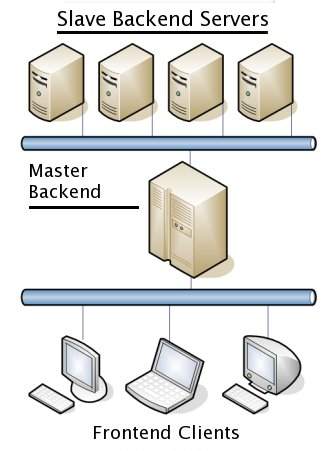Technical Discussion
The MythTV framework is comprised of two basic and unique parts: the backend and frontend nodes. For a basic stand-alone configuration, there needs to be only a single backend server to service one frontend client, usually both running on the same computer. However, the flexibility of this network architecture permits more complex arrangements that scale to multiple backend servers and frontend clients on several computers, media extenders and converted game stations. In theory, MythTV's network topology can scale to an unlimited number of frontend processes, all simultaneously interacting with backend servers. Practically speaking, however, we're aware of some implementations that might have as many as half a dozen frontends running alongside up to as many as 10 backends.
The following image shows a diagram that illustrates this arrangement.

The MythTV network architecture is modularized and scalable.
A MythTV network depicted above can handle front- and backend roles from humble home theater PC (HTPC) configurations to enterprise-wide video content delivery systems. As a rather naïve example, a university might use MythTV to record and stream multiple channels through multiple tuner cards and make simultaneous delivery to any participating frontend client.
However you dig into it, MythTV allows you to get your hands dirty and build a massive highly-customized entertainment unit in the process. Any perceived difficulty in its setup or usage is ultimately balanced by nearly unlimited freedom and potential in the final system (or collection of systems) you pull together in your MythTV environment. Windows MCE may make media centers of other computers, but requires separately-licensed MCE products for each computer involved. MythTV works as an add-on to a variety of systems including Linux, BSD and Mac OSX - in fact, even Windows supports a MythTV frontend client.
Get Tom's Hardware's best news and in-depth reviews, straight to your inbox.
Ed Tittel is a long-time IT writer, researcher and consultant, and occasional contributor to Tom’s Hardware. A Windows Insider MVP since 2018, he likes to cover OS-related driver, troubleshooting, and security topics.
